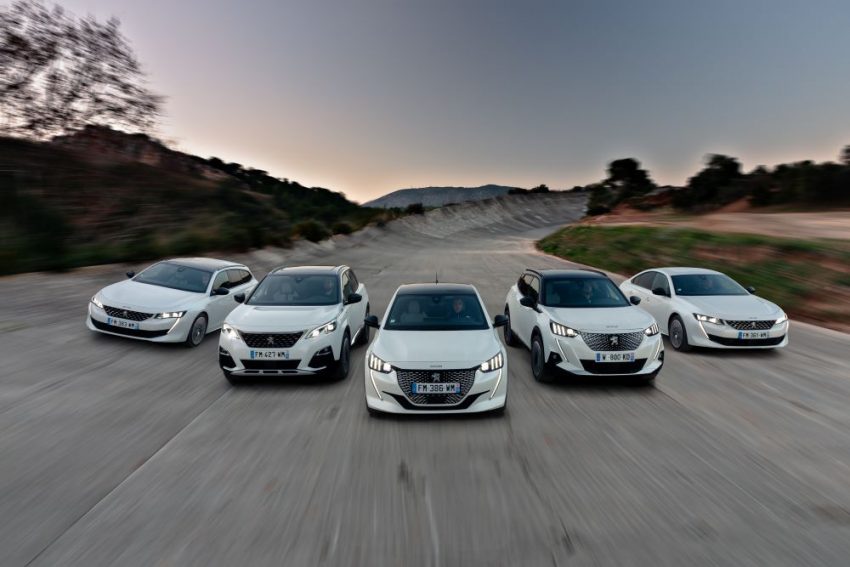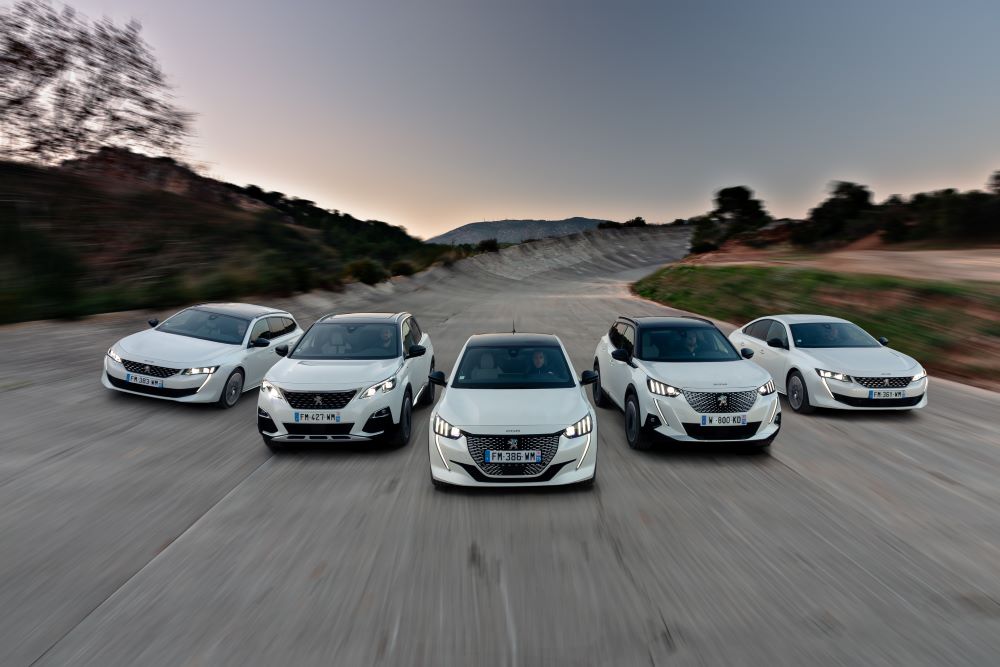
Global 1.7.2020 am Main. The future of the automotive industry is dedicated to sustainable mobility solutions. PEUGEOT offers, therefore, the model already today, many pure-electric variants. Recipients of the state benefits for eco-friendly and financial support for driver and manufacturer. New plug-in hybrid* (combined) with CO2 emissions of 36 g/km there. Eco-friendly wide drivers, PEUGEOT gives you the freedom to choose for motorized.
PEUGEOT Haico van der Lust Germany, general manager, we offer a wide range of vehicles with zero or very low CO2 emissions, “he said. Pure electric models to the promotion of an environment-conscious mobility the key to attractive opportunities to the buyer and the buyer shows. Now, also we offer very attractive financing and leasing.“
Low-emission models of a wide variety of drivers
-Free 100 kW (136 hp) with an electric motor with g/km: 0* new Peugeot e-2008 (energy consumption: 17,8 kWh/100 km1; CO2 emissions) which is as ambitious as g/km 208 (energy consumption: 17.6 kWh/100 km1; CO2 emissions: 0*), Peugeot’s new e-go drive and drive-completely emission. The vehicle’s CO2 emissions without emission of a range of 340 miles to WLKP-Norm1 provides. PEUGEOT’s compact city car, SUV and a larger sedan for e-Traveller4 also a full electric light commercial vehicle in addition to PEUGEOT, the new PEUGEOT model e-Expert4 offers.
1.5 L/100 km for the new plug-in, Peugeot 508 HYBRID (fuel consumption: 1,4*; L/100 km 1.5* g/km CO2 emissions* 35; energy consumption: 15.8 and 15.3 kWh/100 km1 L/100 km fuel consumption:) g/km CO2: 35 – 32* energy consumption: 15,3 – and 18.3 kWh/100 km2) as the Peugeot 3008 HYBRID4 and Peugeot 3008 HYBRID (fuel consumption: * 1.5; CO2 g/km emissions:* 35; energy consumption: The 15.6 – 15,2 kWh/100 km2) combines the latest technology with efficient engines. The plug combines among the best in the market for high performance, Peugeot 3008 HYBRID4* low CO2 per kilometer in hybrid CO2 emissions: 35 g, according to NEFZ2. (200 HP)* 1.6 L 147 kW with PureTech engines and two electric motors each of them with the front and rear suspension installed, 220 kW PEUGEOT* 3008 HYBRID4 strong overall performance (300 PS)*. Completely electrically compact SUV offers a range of 59 miles, according to the Standard 2 WLKP.
Because of the last Peugeot burners, modern and PureTech BlueHDi engine, low CO2 values to obtain. 17 gasoline, hybrid, Diesel, and electricity in the case of plug or under the total combined CO2 95 g/km emissions. * PEUGEOT 3008 up or SUV* HYBRID* both the Peugeot 3008 HYBRID4 like* customers eco-conscious drivers have to choose between several models with sedan Peugeot 508 SW Peugeot 508* and variant station wagon small car, the Peugeot 108 and the new Peugeot 208** Peugeot 308 compact car * coupe.
Innovations and eco-friendly technologies
The development of eco-conscious technologies, PEUGEOT, continuously tries to optimize internal combustion engines. Groupe PSA, Lion Brand, year, vehicle fuel since 2000 has produced countless innovations to reduce the consumption and emission. Thus, the BlueHDi diesel engines equipped with DPF particulate filter, particulate emissions, eliminates 99.9% of. In addition, (SCR) and selective catalytic reduction by 2014, 90 percent reduces nitrogen oxide emissions in diesel engines since the Peugeot. 2014 PureTech petrol engine, a particulate filter delivered since the series, moderately depressed, with 75% removal efficiency of particulate emissions with passive Regeneration.
The latest Peugeot plug in the case of hybrid models, puretech petrol engine combined with two electric motors. Expert4 released until the end of 2020 2008* e and peugeot-PEUGEOT PEUGEOT light commercial vehicles as well as Traveller4 E E-208* e– PEUGEOT – – 100% electric, especially a responsible activity.
Also, in the future, Lion brand is committed to alternative drive systems. So for light trucks for each model, an electric version of the Peugeot compact SUV vehicles by 2025, with goals.
95 g/km overview of models with CO2 emissions (combined)
Model
Engine
G/km combined CO2 emissions
PEUGEOT 108
1.0 L VTi 72*
Eighty five
Peugeot 208
1.2 L PureTech 75*
Ninety four
Peugeot 208
1.5 L BlueHDi 100*
Eighty five
PEUGEOT e-208
Electric motor, 50 kWh, 100 kW*
Zero
PEUGEOT e-2008
Electric motor, 50 kWh, 100 kW*
Zero
Peugeot 308
130 1.5 L BlueHDi*
Ninety five
Peugeot 308
1.5 L BlueHDi 130 EAT8*
Ninety three
Peugeot 3008
225 HYBRID e-EAT8*
(133 kW) 1.6 L PureTech 180 and the electric motor (81 kW) 110 hp
(Weighted and combined)35
Peugeot 3008
300 HYBRID4 e-EAT8*
(83/81 kW) (1.6 L pure (147 kW) 200 hp and two electric motors technology 112/110
(Weighted and combined)35
Peugeot 508
130 1.5 L BlueHDi*
Ninety three
Peugeot 508
1.5 L BlueHDi 130 EAT8*
Ninety two
Peugeot 508
225 HYBRID e-EAT8*
(133 kW) 1.6 L PureTech 180 and the electric motor (81 kW) 110 hp
32 – 35
PEUGEOT 508 SW
130 1.5 L BlueHDi*
Ninety four
PEUGEOT 508 SW
1.5 L BlueHDi 130 EAT8*
Ninety four
PEUGEOT 508 SW
225 HYBRID e-EAT8*
(133 kW) 1.6 L PureTech 180 and the electric motor (81 kW) 110 hp
33 – 36
PEUGEOT e-Navigator
Electric motor, 50 or 75 kWh per kWh4
Zero
PEUGEOT e-Expert
Electric motor, 50 or 75 kWh per kWh4
Zero
Peugeot 108 (53 kW) 1.0 L VTi with 72 L/100 km fuel consumption 3,73
For 853 g/km combined CO2 emissions:
L/100 km fuel consumption (55 kW) Peugeot 208 1.2 L PureTech combined for 75: 4,13
G/km CO2 emissions combined: 943
L/100 km fuel consumption (75 kW) for a Peugeot 208 1.5 L BlueHDi 100 combined: 3.23
853 combined g/km of CO2 emissions:
For 17,61 (100 kW) electric motor with 136 hp PEUGEOT e kWh/100 km1 energy consumption-208:
G/km CO2 emissions combined: 01
PEUGEOT e-2008 (100 kW) 136 hp electric motor for kWh/100 km1 energy consumption: up to 17,81
G/km CO2 emissions combined: 01
L/100 km fuel consumption (96 kW) 130 1.5 L for Peugeot 308 BlueHDi 3,63 combined:
G/km combined CO2 emissions: 953
L/100 km fuel consumption 1.5 L Peugeot 308 BlueHDi (96 kW) 130 EAT8: 3,63 combined to
G/km CO2 emissions combined: 933
L/100 km Peugeot 3008 HYBRID fuel consumption (81 kW) 1.6 110 hp (133 kW) 180 L PureTech engine combined to 1.52 from:
G/km CO2 emissions combined: 352; power consumption: 15.8 and 15.3 kWh/100 km2
L/100 km fuel consumption (83/81 kW) 1.6 L Peugeot 3008 HYBRID4 pure 112/110 with HP (147 kW) 200 technology and two electric motors combined: 1.52
G/km CO2 emissions combined: 352; power consumption: 15.6 – 15,2 kWh/100 km2
L/100 km fuel consumption (96 kW) 130 for the 1.5 L Peugeot 508 BlueHDi combined: 3,53
G/km CO2 emissions combined: 933
L/100 km fuel consumption (96 kW) 130 for the 1.5 L Peugeot 508 BlueHDi EAT8 3,53 combined:
G/km combined CO2 emissions: 923
L/100 km fuel consumption of the Peugeot 508 HYBRID (81 kW) 1.6 110 hp (133 kW) and an electric motor for 180 L PureTech 1.5 – 1,42 combined:
G/km CO2 emissions of 35 – 322; energy consumption: 15,3 – and 18.3 kWh/100 km2 combined:
L/100 km fuel consumption of Peugeot 508 SW 1.5 (96 kW) 130 l BlueHDi: 3,63 combined to
G/km CO2 emissions combined: 943
L/100 km fuel consumption (96) for Peugeot 508 SW BlueHDi 3,63 kW 102 hp 1.5 L with 130 EAT8 combined:
G/km CO2 emissions combined: 943
L/100 km fuel consumption HYBRID Peugeot 508 SW (81 kW) 1.6 110 hp (133 kW) and an electric motor for 180 L PureTech, 1,6 – 1,42 combined:
332; energy consumption: 15,7 – by 14.7 kWh/100 km2 36 combined g/km CO2 emissions:
1, New energy consumption and CO2 emissions of the world “edited Light Vehicles Test Procedure” (this WLKP) according to were determined. Model series represents the average value of the corresponding specified ranges and values. Under everyday conditions may be different, for example, the equipment, the options selected, tires, exterior temperature, track status or personal driving style depends on various factors. The energy consumption and the official specific CO2 emissions of the new car for more information about the official, authoritative, current version of the measurement procedure, according to the “guide about fuel consumption, CO2 emissions and energy consumption of new passenger cars for sale in Germany available, downloadable, or fee on the internet http://www.dat.de as free free and all can be found on the sales floor. According to this information, the measuring process prescribed in the currently valid version have been identified. More information about the CO2 efficiency classes, including graphical representations, can be found here: https://www.peugeot.de/energieeffizienzklassen.html
2, fuel and energy consumption and CO2 emissions new “worldwide (WLTP) light vehicles test procedure” will be compatible and included for comparison purposes, also the previous NEDC-back was determined according to the standard. Higher values generally tend to be more realistic because of the NEDC test conditions values WLKP. For tax assessment and, if any, since 1 note the fees with another vehicle. September 2018 will be used as the basis for calculation of the determined values for wlkp. Wlkp power consumption and only disclose the range and a full charge of the battery for the first 100 km we will refer to in connection with. Model series represents the average value of the corresponding specified ranges and values. Under everyday conditions may be different, for example, the equipment, the options selected, tires, exterior temperature, track status or personal driving style depends on various factors. Official fuel consumption and official specific CO2 emissions new passenger vehicle emissions and energy for more information about is available for free or available free www.dat.de providing fuel consumption, CO2 emissions and energy consumption of new passenger cars “grid” can be taken as. According to this information, the measuring process prescribed in the currently valid version have been identified. More information about the CO2 efficiency classes, including graphical representations, can be found here: https://www.peugeot.de/energieeffizienzklassen.html
3, fuel consumption and CO2 emissions new “worldwide (WLTP) light vehicles test procedure” will be compatible and included for comparison purposes, also the previous NEDC-back was determined according to the standard. Higher values generally tend to be more realistic because of the NEDC test conditions values WLKP. Peugeot 308 BlueHDi 1.5 L 130 final approval for the subject technical data. For tax assessment and, if any, since 1 note the fees with another vehicle. September 2018 will be used as the basis for calculation of the determined values for wlkp. Therefore, the evaluation values given here are different from the values of such taxes and fees may apply. To find out the individual CO2, road tax for a tool to be used for emission according wlkp please refer to the contractual partner. All given values, equipment, and options may vary depending on the tires. Official fuel consumption and official specific CO2 emissions of new cars and energy, the measurement procedure according to the current official version, more information about about the fuel consumption downloadable “guide, all new passenger car models available for sale in Germany, authorized, or on the internet www.dat.de free and for free all the available sales CO2 emissions and energy consumption can be found. According to this information, the measuring process prescribed in the currently valid version have been identified. More information about the CO2 efficiency classes, including graphical representations here https://www.peugeot.de/energieeffizienzklassen.html you can find:.
4, the interval specified in (EU) (Regulation (EC) no 715/2007 and Regulation No test procedure has been identified as 2017/1151 wlkp. A range of real circumstances vary every day and several factors, in particular, personal driving style, as well as the thermal limit, as is the terrain, ambient temperature, depends on the use of air conditioning and heating.
Official measurement in accordance with the procedure information.


(Source: black)